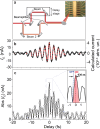Light-induced quantum tunnelling current in graphene
- PMID: 40346098
- PMCID: PMC12064659
- DOI: 10.1038/s41467-025-59675-5
Light-induced quantum tunnelling current in graphene
Abstract
In the last decade, advancements in attosecond spectroscopy have allowed researchers to study and manipulate electron dynamics in condensed matter via ultrafast light fields, offering the possibility to realise ultrafast optoelectronic devices. Here, we report the generation of light-induced quantum tunnelling currents in graphene phototransistors by ultrafast laser pulses in an ambient environment. This tunnelling effect provides access to an instantaneous field-driven current, demonstrating a current switching effect (ON and OFF) on a ~630 attosecond scale (~1.6 petahertz speed). We show the tunability of the tunnelling current and enhancement of the graphene phototransistor conductivity by controlling the density of the photoexcited charge carriers at different pump laser powers. We exploited this capability to demonstrate various logic gates. The reported approach under ambient conditions is suitable for the development of petahertz optical transistors, lightwave electronics, and optical quantum computers.
© 2025. The Author(s).
Conflict of interest statement
Competing interests: The authors declare no competing interests.
Figures




Similar articles
-
Light-field-driven currents in graphene.Nature. 2017 Oct 12;550(7675):224-228. doi: 10.1038/nature23900. Epub 2017 Sep 25. Nature. 2017. PMID: 28953882
-
Multi-petahertz electronic metrology.Nature. 2016 Oct 20;538(7625):359-363. doi: 10.1038/nature19821. Nature. 2016. PMID: 27762353
-
Ultrafast optical switching and data encoding on synthesized light fields.Sci Adv. 2023 Feb 22;9(8):eadf1015. doi: 10.1126/sciadv.adf1015. Epub 2023 Feb 22. Sci Adv. 2023. PMID: 36812316 Free PMC article.
-
The 2021 ultrafast spectroscopic probes of condensed matter roadmap.J Phys Condens Matter. 2021 Jul 5;33(35). doi: 10.1088/1361-648X/abfe21. J Phys Condens Matter. 2021. PMID: 33951618 Review.
-
Graphene barristors for de novo optoelectronics.Chem Commun (Camb). 2023 Jan 24;59(8):974-988. doi: 10.1039/d2cc05886c. Chem Commun (Camb). 2023. PMID: 36607612 Review.
References
-
- Krausz, F. & Ivanov, M. Attosecond physics. Rev. Mod. Phys.81, 163 (2009).
-
- Corkum, P. & Krausz, F. Attosecond science. Nat. Phys.3, 381–387 (2007).
-
- Nisoli, M. & Sansone, G. New frontiers in attosecond science. Prog. Quantum Electron.33, 17–59 (2009).
-
- Ghimire, S. et al. Observation of high-order harmonic generation in a bulk crystal. Nat. Phys.7, 138–141 (2011).
-
- Cavalieri, A. L. et al. Attosecond spectroscopy in condensed matter. Nature449, 1029–1032 (2007). - PubMed
Grants and funding
LinkOut - more resources
Full Text Sources
Miscellaneous

